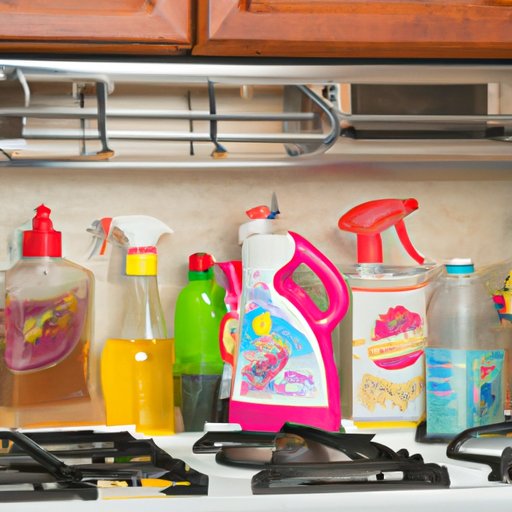Introduction
Grease and grime can build up on your kitchen cabinets over time, making them look dull and dingy. This can be especially true in high-traffic kitchens where food is often being cooked and prepared. Fortunately, there are several easy steps you can take to get your cabinets looking like new again. In this article, we’ll explore how to clean grease on kitchen cabinets using simple household supplies as well as more powerful cleaning solutions.
Benefits of Cleaning Grease from Kitchen Cabinets
Cleaning grease from kitchen cabinets has a number of benefits. Not only will it make your cabinets look more attractive, but it can also help protect them from further damage. Grease and dirt can wear down the finish on your cabinets, making them more susceptible to scratches and other signs of wear and tear. Taking the time to clean your cabinets regularly will help keep them looking their best for years to come.

Step 1: Use Dish Soap and Hot Water
The first step in cleaning grease from kitchen cabinets is to use dish soap and hot water. Gather the following supplies:
- Dish soap
- Hot water
- Soft cloths or sponges
Start by mixing a few drops of dish soap into a bucket of hot water. Dip a soft cloth or sponge into the soapy water, then wring it out until it’s damp. Begin wiping down the cabinet surfaces, taking care to remove any visible grease or grime. Once you’ve wiped down all the cabinets, rinse them with warm water. Dry with a clean cloth or towel.

Step 2: Wipe Down with Vinegar and Baking Soda
If there’s still grease present on your kitchen cabinets after using dish soap and hot water, try wiping them down with a mixture of vinegar and baking soda. Gather the following supplies:
- White vinegar
- Baking soda
- Soft cloth or sponge
Mix together equal parts vinegar and baking soda to form a paste. Dip a soft cloth or sponge into the paste, then wipe down the cabinets. Let the paste sit for several minutes before wiping away with a damp cloth. Rinse with warm water and dry with a clean cloth or towel.
Step 3: Apply Degreaser or Grease-Cutting Cleaner
If the vinegar and baking soda mixture doesn’t do the trick, you may need to use a degreaser or grease-cutting cleaner. Be sure to read the directions carefully before using any type of chemical cleaner. Put on gloves to protect your hands from harsh chemicals. Apply the cleaner to the cabinets, then scrub with steel wool or a stiff brush. Wipe away the cleaner with a damp cloth, then rinse with warm water and dry with a clean cloth or towel.

Step 4: Use a Pressure Washer
For particularly stubborn grease and grime, you may want to use a pressure washer. Gather the necessary equipment, including a pressure washer, hose, and nozzle. Set up the pressure washer according to the manufacturer’s instructions. Test the settings before applying the cleaner to the cabinets. Apply the cleaner to the cabinets, then scrub with steel wool or a stiff brush. Use the pressure washer to remove the grease and grime from the cabinets. Rinse with warm water and dry with a clean cloth or towel.
Conclusion
Getting rid of grease and grime on kitchen cabinets doesn’t have to be difficult. With the right supplies and a little elbow grease, you can have your cabinets looking like new in no time. Start by using dish soap and hot water, then move on to a vinegar and baking soda mixture. If that doesn’t work, try a degreaser or grease-cutting cleaner. For particularly tough jobs, you may need to use a pressure washer. Following these steps should help you restore your cabinets to their former glory.
Tips for Prevention
In addition to cleaning your kitchen cabinets regularly, there are a few things you can do to prevent grease and grime buildup. Wipe down the cabinets after each use with a damp cloth. Place mats or trays under pans and dishes to catch any drips or spills. Finally, use a silicone-based lubricant on the hinges and other moving parts to keep them working smoothly.


